Related Research Articles

A fairy is a type of mythical being or legendary creature, generally described as anthropomorphic, found in the folklore of multiple European cultures, a form of spirit, often with metaphysical, supernatural, or preternatural qualities.
A trow is a malignant or mischievous fairy or spirit in the folkloric traditions of the Orkney and Shetland islands. Trows may be regarded as monstrous giants at times, or quite the opposite, short-statured fairies dressed in grey.

A kelpie, or water kelpie, is a shape-shifting spirit inhabiting lochs in Irish and Scottish folklore. It is usually described as a grey or white horse-like creature, able to adopt human form. Some accounts state that the kelpie retains its hooves when appearing as a human, leading to its association with the Christian idea of Satan as alluded to by Robert Burns in his 1786 poem "Address to the Devil".
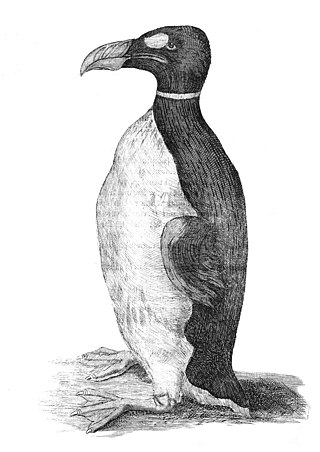
The boobrie is a mythological shapeshifting entity inhabiting the lochs of the west coast of Scotland. It commonly adopts the appearance of a gigantic water bird resembling a cormorant or great northern diver, but it can also materialise in the form of various other mythological creatures such as a water bull.

Merrow is a mermaid or merman in Irish folklore. The term is anglicised from the Irish word murúch.
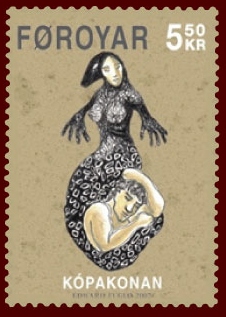
Selkies are mythological creatures that can shapeshift between seal and human forms by removing or putting on their seal skin. They feature prominently in the oral traditions and mythology of various cultures, especially those of Celtic and Norse origin. The term “selkie” derives from the Scots word for “seal”, and is also spelled as silkies, sylkies, or selchies. Selkies are sometimes referred to as selkie folk, meaning 'seal folk'. Selkies are mainly associated with the Northern Isles of Scotland, where they are said to live as seals in the sea but shed their skin to become human on land.
Irish folklore refers to the folktales, balladry, music, dance and mythology of Ireland. It is the study and appreciation of how people lived.

Scottish mythology is the collection of myths that have emerged throughout the history of Scotland, sometimes being elaborated upon by successive generations, and at other times being rejected and replaced by other explanatory narratives.
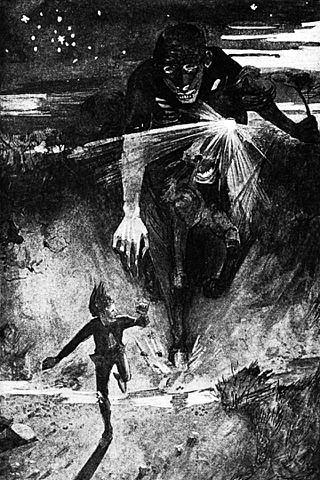
The nuckelavee or nuckalavee is a horse-like demon from Orcadian folklore that combines equine and human elements. British folklorist Katharine Briggs called it "the nastiest" of all the demons of Scotland's Northern Isles. The nuckelavee's breath was thought to wilt crops and sicken livestock, and the creature was held responsible for droughts and epidemics on land despite being predominantly a sea-dweller.
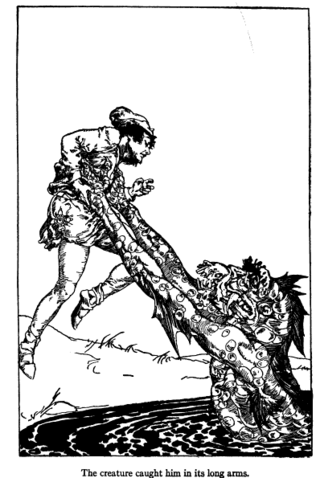
A fuath is a class of malevolent spirits in Scottish Highland folklore, and less commonly Irish Folklore especially water spirits.

The cù-sìth(e), plural coin-shìth(e) is a mythical hound found in Irish folklore and Scottish folklore. In Irish folklore it is spelled cú sídhe, and it also bears some resemblance to the Welsh Cŵn Annwn.

Glashtyn is a legendary creature from Manx folklore.
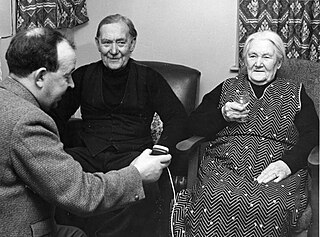
Calum Iain Maclean, was a Scottish folklorist, collector, ethnographer and author.
A nuggle, njuggle, or neugle, is a mythical water horse of primarily Shetland folklore where it is also referred to as a shoepultie or shoopiltee on some parts of the islands. A nocturnal creature that is always of a male gender, there are occasional fleeting mentions of him connected with the Orkney islands but he is more frequently associated with the rivers, streams and lochs of Shetland. He is easily recognised by his distinctive wheel-like tail and, unlike his evil counterparts the each-uisge or the nuckelavee, has a fairly gentle disposition being more prone to playing pranks and making mischief rather than having malicious intents.
In Scottish folklore the Ghillie Dhu or Gille Dubh was a solitary male fairy. He was kind and reticent, yet sometimes wild in character. He had a gentle devotion to children. Dark-haired and clothed in leaves and moss, he lived in a birch wood within the Gairloch and Loch a Druing area of the north-west Highlands of Scotland. Ghillie Dhu is the eponym for the ghillie suit.

John Gregorson Campbell was a Scottish folklorist and Free Church minister at the Tiree and Coll parishes in Argyll, Scotland. An avid collector of traditional stories, he became Secretary to the Ossianic Society of Glasgow University in the mid-1850s. Ill health had prevented him taking up employment as a Minister when he was initially approved to preach by the Presbytery of Glasgow in 1858 and later after he was appointed to Tiree by the Duke of Argyll in 1861, parishioners objected to his manner of preaching.

The blue men of the Minch, also known as storm kelpies, are mythological creatures inhabiting the stretch of water between the northern Outer Hebrides and mainland Scotland, looking for sailors to drown and stricken boats to sink. They appear to be localised to the Minch and surrounding areas to the north and as far east as Wick, unknown in other parts of Scotland and without counterparts in the rest of the world.
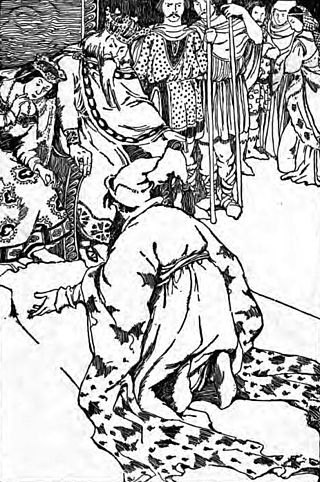
Assipattle and the Stoor Worm is an Orcadian folktale relating the battle between the eponymous hero and a gigantic sea serpent known as the stoor worm. The tale was preserved by 19th-century antiquarian Walter Traill Dennison, and retold by another Orcadian folklorist, Ernest Marwick, in a 20th-century version that integrates Dennison's texts with tidbits from other oral storytellers.
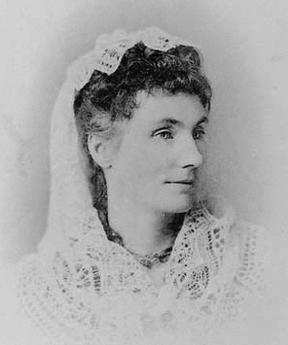
Jessie Margaret Edmondston Saxby was a writer and folklorist from Unst, one of the Shetland Islands of Scotland. She also had political interests and was a suffragette.
Gwragedd Annwn, alternatively known as Dames of the Lower Region, Dames of Elfin Land, or Wives of the Lower World, are beautiful female fairies who live beneath lakes and rivers found in Welsh folklore. They are counted among the Tylwyth Teg or Welsh fairy folk.The mythological narrative of Gwragedd Annwn is intertwined with the origin of the Welsh black cattle. Some legends hold that the existence of the Gwragedd Annwn was owed to the famed Saint Patrick. Occasionally, the fairies were said to ascend into the upper world, and be visible to ordinary people.
References
- ↑ Bane, Theresa (2013). Encyclopedia of Fairies in World Folklore and Mythology. McFarland. p. 346. ISBN 978-1-4766-1242-3.
- 1 2 3 Smith, Brian (18 May 2021). "The real story behind the Shetland wulver". Shetland Museum Archives.
- 1 2 Allardice, Pamela (1990). Myths, Gods and Fantasy: A Sourcebook. Prism Press. p. 224. ISBN 1853270520.
- 1 2 3 Briggs, Katherine Mary (1976). A Dictionary of Fairies: Hobgoblins, Brownies, Bogies, and Other Supernatural Creatures. Pantheon books, New York. pp. 445–446. ISBN 0-394-40918-3.
- ↑ Narváez, Peter (1991). The Good People: New Fairylore Essays. Garland Pub. p. 243. ISBN 9780824071004.
- 1 2 "Six ancient myths from the Scottish islands". The Scotsman. 7 July 2016.
- ↑ Saxby, Jessia (1932). Shetland Traditional Lore. Grant and Murray. p. 141.
- ↑ Saxby, Jessie (11 January 1930). "Trows and Their Kindred, Part II". The Shetland Times.
- ↑ Saxby, Jessie (1905). "Sacred Sites in a Shetland Isle". The Antiquary. 41: 138.
- ↑ Black, Ronald (2005). The Gaelic Otherworld: John Gregorson Campbell's Superstitions of the Highlands and Islands of Scotland and Witchcraft and Second Sight in the Highlands and Islands.
- ↑ Eberly, Susan Schoon (1988). "Fairies and the Folklore of Disability: Changelings, Hybrids and the Solitary Fairy". Folklore. 99 (1): 58–77. doi:10.1080/0015587X.1988.9716425. JSTOR 1259568.
- ↑ Schmiesing, Ann (2014). Disability, Deformity, and Disease in the Grimms' Fairy Tales. Wanye State University Press. p. 7. ISBN 978-0-8143-3841-4.